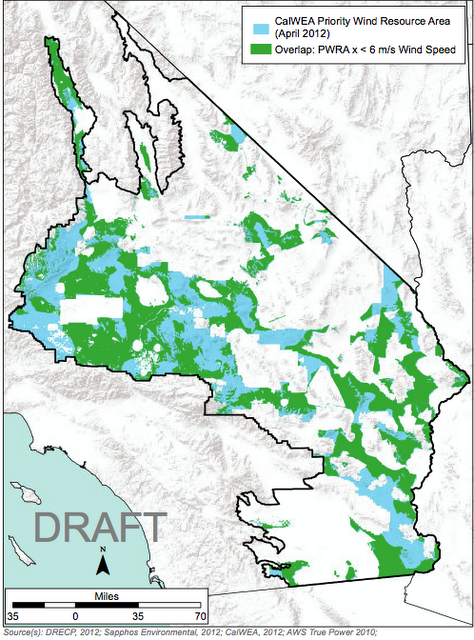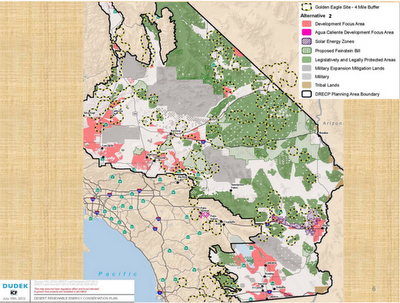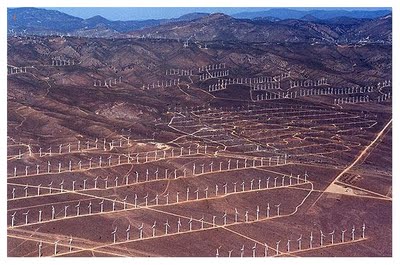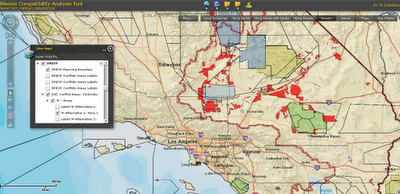Desert lands policy: Wind industry gets reality check
Credit: Mojave Desert Blog | www.mojavedesertblog.com 14 August 2012 ~~
Translate: FROM English | TO English
Translate: FROM English | TO English
If you have been listening to the the past few stakeholder conferences for the Desert Renewable Energy Conservation Plan (DRECP) – an inter-agency effort to protect desert ecosystems while identifying areas suitable for renewable energy in California’s deserts – then you know that representatives from the California Wind Energy Association (CalWEA) sound disappointed as their plans to industrialize much of California’s desert wildlands meet resistance. Some of the DRECP’s proposed development focus areas would only accommodate 2-17% of the nearly 2 million acres to which the wind industry initially requested access. The wind industry expressed frustration during the meetings, wondering aloud why they cannot bulldoze desert, carve hundreds of miles of new roads, and set up massive wind turbines standing over 400 feet tall across public lands.
It is a rude awakening for CalWEA and other industry officials to the realities of the desert, where stakeholders have been in line to exploit or enjoy the open landscapes long before the energy industry discovered a way to make profit in the desert. At the end of the DRECP stakeholders process, it became evident that many areas sought after by the wind industry are of high importance not only to wildlife, but to military and recreation stakeholders, as well.

This map shows the areas in California’s desert region where the California Wind Energy Association (CalWEA) expected to have the ability to build industrial wind energy facilities. The blue areas depict the “priority wind resoure areas”, while the green shaded areas show portions of the priority wind resource areas where the average wind speed is high enough to justify investment under current market conditions – clearly an overreach by the wind industry.
US Fish and Wildlife Service (USFWS) officials involved in the DRECP process have taken a cautious approach to permitting wind energy facilities on desert lands, according to their presentation at a late July DRECP meeting. The officials indicated the need to prevent the decimation of the desert’s fragile golden eagle population as it considers industry requests to build in the region, and the need for continued research on golden eagle presence and behavior. The USFWS officials are considering siting practices that would limit or prohibit the construction of wind turbines or solar “power towers” within 4 miles of an active golden eagle nest, and limiting overall take – the harassment or death of golden eagles – to 5% of the total population in California.

The map above was presented by the US Fish and Wildlife Service (USFWS) to the DRECP stakeholders showing known golden eagle nests and projected four mile buffer zones where wind industry development presumably would be limited or prohibited.
USFWS probably wants to avoid the scenarios that have already played out at the Pine Tree Wind project
in the western Mojave Desert, which has already killed several golden
eagles and may be one of the deadliest to birds and bats. The wind
industry’s own version of science claims that avian mortality can be
reduced with bigger turbines, yet the Pine Tree project already uses
such large turbines, and a new study suggests that the large turbines may be more deadly to bats.
The wind industry’s response to USFWS has been hostile. CalWEA officials at the July stakeholders meeting for the DRECP claimed that the science behind USFWS concern was lacking – an ironic statement to make for an industry that is coordinating with the pro-wind American Wind Wildlife Institute to produce “studies” that support industry’s own version of “science,” according to a leaked wind industry strategy document.
During the DRECP stakeholders meeting, wind industry representatives claimed that wildlife and industrial facilities can coexist – claims reminiscent of BrightSource Energy’s propaganda suggesting that desert ecosystems could flourish underneath the company’s massive mirrors and steel towers, even though vegetation is mowed down and soil is compacted or graded. The bottom line is that wind industry facilities on wildlands require miles of new roads wide enough to accommodate construction vehicles and the delivery and installation of towers over 400 feet tall. The construction activity destroys habitat, contributed to erosion of soils, and introduces invasive plant species. Once in place, the tower’s spinning blades pose a threat to birds and bats, with over 440,000 birds being killed each year, according to a study highlighted by the American Bird Conservancy.

An aerial photo of wind turbines in the western Mojave Desert, pushing raptors from foraging territory and industrializing otherwise peaceful desert habitat.
CalWEA likely expected the challenge from wildlife officials attempting to maintain the integrity of desert ecosystems. What they did not expect was the Department of Defense’s interest in protecting a unique area for training and testing among an assemblage of military bases in the desert that has not be replicated anywhere else in the world. As noted by the Press-Enterprise in a May article, Defense officials have expressed concern to the DRECP stakeholders that spinning wind turbine blades interfere with radar signals, and that super-heated solar “power towers” can distract the thermal image-based targeting sensors of military weapons. If wind and solar “power tower” facilities proliferate across the desert, training and testing ranges used by the Department of Defense would be disrupted.

This screen shot of a map presented by the Department of Defense to DRECP stakeholders shows in red the DRECP’s development focus areas where wind facilities would conflict with the military’s mission needs. Other areas in blue, green and yellow depict military bases and training areas.
The Department of Defense plans to identify a “red zone” in California’s desert where it would oppose most wind energy facilities, although the Department did express a willingness to consider projects on a case-by-case basis to determine whether or not interference with military activities could be mitigated. It’s not clear how this policy will play out, and some stakeholders questioned how wind facilities have been permitted in the western Mojave Desert, which appears to be included in the proposed “red zone.” Yet BLM records also indicated that some wind projects have been stymied by military concerns, including Iberdola’s planned Silurian Valley Wind project, which would destroy dozens of square miles of pristine desert north of Baker, California.
The military is already claiming some prized off-highway vehicle (OHV) recreation areas as new training grounds – now the wind industry wants to challenge the military and recreational visitors to the rest of the desert. Although the wind industry claims that the public will still have access to desert lands where wind facilities are built, the reality on the ground has been mixed. Visitors – including hikers and OHV riders – have been barred from parts of Jawbone Canyon in the western Mojave Desert where wind facilities have been under construction. Other visitors will find the landscapes unattractive – the quiet and open deserts marred by the blight of massive and loud wind turbines. The desert is often seen as a quiet getaway by many visitors. According to a poll of visitors to Joshua Tree National Park, nearly 90% cited “views without development” as the reason for visiting the desert wildlands. Towers taller than the Statue of Liberty and new transmission lines probably are not compatible with the peaceful solitude many expect to find in the desert.
Local officials from the USFWS and military seem to be taking a policy approach that carefully considers the impact of industrial-scale energy facilities on desert resources – a breath of fresh air from the typically blind approval the wind industry receives from political appointees and national environmental groups inside Washington’s Beltway. CalWEA and the larger American Wind Energy Association have coordinated efforts and invested large sums of money to buy political support for the industry, which depends on access to vast swaths of public lands to continue making profit. The industry likely will continue challenging science-based concerns by USFWS and the military in favor of Wall Street’s bottom line, lobbying the White House and the Secretary of Interior to undermine barriers in its way.
This article is the work of the source indicated. Any opinions expressed in it are not necessarily those of National Wind Watch.
The copyright of this article resides with the author or publisher indicated. As part of its noncommercial educational effort to present the environmental, social, scientific, and economic issues of large-scale wind power development to a global audience seeking such information, National Wind Watch endeavors to observe “fair use” as provided for in section 107 of U.S. Copyright Law and similar “fair dealing” provisions of the copyright laws of other nations. Send requests to excerpt, general inquiries, and comments via e-mail.
| Wind Watch relies entirely on User Funding |
 (via Stripe) |
 (via Paypal) |
Share:

